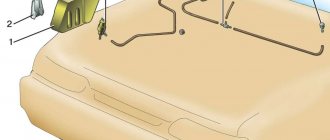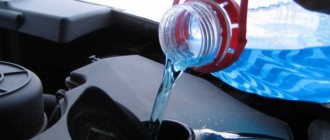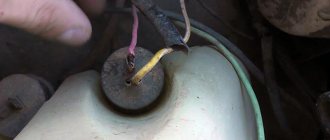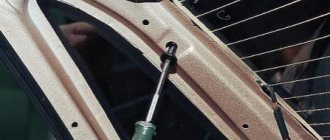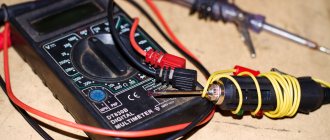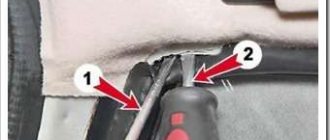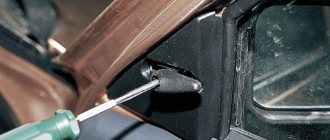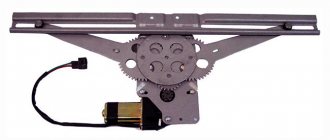Is the windshield washer on your VAZ-2110 broken? No problem!
The windshield washer is a rather useful and necessary invention in the VAZ-2110 car.
This device was created to make life easier for drivers. When there are no problems with the windshield washer on a VAZ-2110 car, we simply do not notice it and perceive it as an ordinary thing. But when there is a problem with it, we immediately remember its pricelessness and irreplaceability. It may seem to some that it is simply impossible to drive a VAZ-2110 without a windshield washer. This is true. We quickly get used to good things. The same situation applies to the washer. After all, once upon a time this function was not available in cars, and this suited any driver. At that time it seemed to them that the car had everything they needed and there was nothing more to add.
In this material we will talk specifically about the windshield washer in VAZ-2110 cars. We will look at the possible reasons for its malfunction and learn how to deal with these problems.
At its core, a windshield washer consists of two parts - mechanical and electrical. Malfunctions in this device in VAZ-2110 cars often appear in the mechanical part, but in most cases such problems are insignificant and do not require any effort to eliminate them.
One day, one fine morning, you get into your car and want to wash the windshield. You press the washer button and... Commenting obscenely on what is happening, you get out of the car, take the first rag that comes to hand and go to wipe the glass.
Mechanical reasons why the windshield washer may not work
- The most common reason that drivers do not pay attention to is the lack of fluid in the washer reservoir of the VAZ-2110. We think there is no need to describe the solution to this problem. If the car owner is absolutely sure that there is liquid in the container, and the temperature outside is below 0 degrees Celsius, there is a possibility that it is simply frozen. Some people, instead of special liquid, pour ordinary water into the washer reservoir, and then are surprised that at sub-zero temperatures it turns into ice. This problem is solved by warming the engine up to operating temperature. You can simply leave the VAZ-2110 in a warm garage overnight. After some time, the frozen water in the tank will melt and the windshield washer will start working again. To prevent the problem from recurring, you should replace the regular water in the container with the liquid provided for this.
- Another common reason is that the hose has fallen off. Quite often, the tube through which the liquid is supplied flies off the nozzles or from the tank itself, and the entire contents simply pour out onto the ground. There have also been cases where the hose became pinched under the hood. In such cases, carefully check the fluid supply hoses along the entire length from the washer reservoir to the nozzles on the hood.
- Clogged washer nozzles. Clogged injectors are a fairly common malfunction in the VAZ-2110. This can happen due to poor quality sprayer fluid. It happens that the injectors become clogged not only with sediment from the contents of the tank, but also with dirt from the windshield. To find out, you need to disconnect the hose from the nozzle and check the fluid supply. If water appears at the end of the tube, the injectors are clogged. They can be cleaned or replaced with new ones.
Why the VAZ 2110 washer does not work
This is true, you get used to everything good quickly, the same with the washer, once there was no glass washer or headlight washer, and everyone was happy with everything and it seemed that the car had everything that was needed. Today I propose to talk about the windshield washer and its malfunctions. You will learn why washer does not work, the reasons for its malfunction and where to look for them.
Windshield washer malfunctions can be divided into two categories - electrical and mechanical. Mechanical ones are more common, but they are usually not very difficult, so they are easier to fix than electrical ones.
So, one fine day you sit behind the wheel, decide to wash the glass, press the button and. nothing happens, liquid does not flow, the glass does not wash. What's the matter? This is the first question that comes to mind after a series of obscene expressions :-))).
READ Replacing the hood cable of a VAZ 2110
windshield washer This device was created to make life easier for drivers. When there are no problems with the windshield washer on a VAZ-2110 car, we simply do not notice it and perceive it as an ordinary thing. But when there is a problem with it, we immediately remember its pricelessness and irreplaceability. It may seem to some that it is simply impossible to drive a VAZ-2110 without a windshield washer.
This is true. We quickly get used to good things. The same situation applies to the washer. After all, once upon a time this function was not available in cars, and this suited any driver. At that time it seemed to them that the car had everything they needed and there was nothing more to add.
In this material we will talk specifically about the windshield washer in VAZ-2110 cars. We will look at the possible reasons for its malfunction and learn how to deal with these problems.
At its core, windshield washer Malfunctions in this device in VAZ- 2110 often appear in the mechanical part, but in most cases such problems are insignificant and do not require any effort to eliminate them.
One day, one fine morning, you get into your car and want to wash the windshield. You press the washer button and... Commenting obscenely on what is happening, you get out of the car, take the first rag that comes to hand and go to wipe the glass.
The VAZ 2112 washer does not work. Reason.
Mechanical reasons why windshield washer may not work
- The most common reason that drivers do not pay attention to is the lack of fluid in the washer reservoir of the VAZ-2110. We think there is no need to describe the solution to this problem. If the car owner is absolutely sure that there is liquid in the container, and the temperature outside is below 0 degrees Celsius, there is a possibility that it is simply frozen. Some people, instead of special liquid, pour ordinary water into the washer reservoir, and then are surprised that at sub-zero temperatures it turns into ice. This problem is solved by warming the engine up to operating temperature. You can simply leave the VAZ-2110 in a warm garage overnight. After some time, the frozen water in the tank will melt and the windshield washer working To prevent the problem from recurring, you should replace the regular water in the container with the liquid provided for this.
- Another common reason is that the hose has fallen off. Quite often, the tube through which the liquid is supplied flies off the nozzles or from the tank itself, and the entire contents simply pour out onto the ground. There have also been cases where the hose became pinched under the hood. In such cases, carefully check the fluid supply hoses along the entire length from the washer reservoir to the nozzles on the hood.
- Clogged washer nozzles. Clogged injectors are a fairly common malfunction in the VAZ-2110. This can happen due to poor quality sprayer fluid. It happens that the injectors become clogged not only with sediment from the contents of the tank, but also with dirt from the windshield. To find out, you need to disconnect the hose from the nozzle and check the fluid supply. If water appears at the end of the tube, the injectors are clogged. They can be cleaned or replaced with new ones.
Windshield washer mechanics: nozzles do not spray
So, the mechanical reasons why the windshield washer does not work:
— The washer fluid froze. It seems stupid, but quite often using ordinary water, and with the onset of the first frosts, antifreeze, many drivers forget to remove the water from the washer hoses and pump in antifreeze fluid instead. The water in the pipes turns to ice and the windshield washer does not work
, since the liquid cannot overcome the ice plug. The way out of the situation is to warm up the engine, close the hood and put the car in a room with above-zero temperatures. After a while, the windshield washer will start working.
— the hose jumped off. This is also a fairly common reason. The liquid from the tank does not go to the fittings, but flows somewhere before reaching them.
— the engine shaft turned. Under heavy loads (usually when the liquid in the tank freezes), the motor shaft can rotate inside the part placed on it. This is a fairly common reason on VAZ cars. At the same time, you can hear that the washer motor is humming, but no liquid is pouring onto the glass. In this case, only replacing the entire mechanism will help.
— the hose going to the washer nozzles is pinched. It occurs on cars where the fittings are located on the hood; when it is closed, the hoses become strongly bent and stop passing liquid through them.
The washer nozzles (fittings) become clogged with water deposits.
— the fittings (washer nozzles) are clogged with dirt, ice or water deposits. Remove the hose from the fittings; if liquid comes out, then the problem is in them. They need to be replaced with new ones, especially since they are inexpensive.
It will be useful: VAZ-2103 engine size: technical characteristics
Causes of washer malfunction
If the windshield washer does not work, it will not be difficult for an experienced driver to identify the cause of such a malfunction, and even a beginner, after familiarizing himself with the main failures in the cleaning system, will be able to eliminate them on his own.
Mechanical problems
The most important reason, as mentioned above, may be the lack of washer fluid; in this case, you just need to top it up. If it is present, but does not splash in the winter, then perhaps it is simply frozen. In this case, the problem can be solved in one of two ways:
- warming up the engine;
- bringing the car into a warm garage.
After the liquid has thawed, the system will begin to operate as usual, but it is better to drain the water from the tank after this and replace it with an “anti-freeze” one.
If you are interested in information about how to make an antifreeze with your own hands, read the material from our specialist.
Other significant mechanical reasons why the windshield washer does not spray include the following factors.
- Clogged injectors . Their exit can be blocked by various debris: rust, dirt or small particles. To check the correctness of the guess, you need to stop the supply of working fluid to the nozzles; if this is the case, then the supply of “anti-freeze” will be normal. The solution to this problem lies in replacing the nozzles.
- Disconnecting the hose . It may simply fly off while driving on bumpy roads, and then the fluid supply will continue, but the headlight and windshield washer nozzle will remain dry. Sometimes this happens in cars in which the connecting fittings are located on the hood, then when it is closed, the hoses are squeezed. In any case, the deformed or torn tube must be replaced and returned to its place.
Electrical faults
After checking the fluid level, the cleanliness of the injectors and the hose leading to them, it may turn out that all this has nothing to do with it, then the issue is for the following reasons:
- Fuse blown . You will need to find the safety block and check the insert; it can be found using the attached diagram, which is usually printed on the cover or in the car’s operating instructions. After checking, if this is indeed the reason, then you need to replace the damaged part
- Motor failure . To establish the accuracy of your guess, you should connect a multimeter to the motor terminals and check the voltage when you turn on the washer. If the voltage indicator is normal, but the motor remains inoperative, then the problem lies with it. You can determine which motor has failed by elimination, by moving the pump terminals from the windshield to its rear counterpart.
- Washer switch malfunction . It is usually located on the steering wheel. If, after checking the voltage, it is missing, and replacing the motor with a new unit did not help, then it turns out that the windshield washer switch or relay is not working. Only an experienced auto electrician can accurately diagnose a breakdown.
- Oxidation of pump terminals . During operation, they can not only oxidize, but also completely fall off, which is why the motor stops pumping liquid. To return everything to working condition, you need to clean the oxidized terminals or replace them with new ones.
We recommend: Valve desiccant - how to make a special tool with your own hands?
Electrical glass washer: common problems
Let's look at the electrical reasons why the washer does not work:
— the fuse has blown. We need to get to the fuse box, use reference books or symbols on the cover to find the one we need, check it, and if it is blown, replace it with a new one.
— the terminals attached to the motor terminals have oxidized or decomposed and fallen off. It is necessary to clean the terminals, check the quality of the connections, and put everything back in place. In my opinion, it is best to clean the terminals with a hot soapy solution and a toothbrush.
Why the washer does not work: the fuse is melted or the terminal is faulty
— the washer does not work due to the fact that the washer switch on the steering wheel has failed . If your car automatically turns on the brushes when you press the washer switch and this function works, but the liquid does not splash, then the reason needs to be looked for elsewhere. For those who do not have such a pleasant feature, you should take a multimeter, connect it to the terminals on the washer motor terminals and measure the voltage with the switch pressed. If there is voltage, but the motor does not spin, the latter needs to be replaced. If there is no voltage, then one of three things remains: either the switch does not work, or the washer activation relay does not close, or the electrical wiring is faulty. If replacing the relay did not help, then it is best to contact an auto electrician, or if you yourself understand car wiring, then fixing it will not be so difficult.
Cause of failure due to electrical
Electrical causes may be:
- The fuse may have blown. It is located in the fuse box;
- Check the leads that are equipped with the VAZ 2110 washer motor; it is quite possible that they have oxidized. It happens that the terminals completely fall off;
- The windshield washer switch located on the steering wheel does not work. Its performance can be easily checked with a multimeter;
- Wiring faulty. The wires may need to be replaced;
- The windshield washer relay does not work. The best treatment is also replacement.
Why doesn't the windshield washer work?
The system for cleaning glass and car headlights includes: a liquid reservoir, a pump, nozzles, tubes, electrical wiring and a power button. Most often, the reason why the windshield washer does not work is a faulty motor or a blown fuse. The operating principle of a windshield washer is quite archaic, so simple diagnostics and simple repairs can be performed almost at the doorstep of the nearest auto parts store.
Malfunctions and operating principles of hand and foot-operated windshield washers, which were installed on some VAZ and AZLK models, deserve a separate topic and will not be discussed in this article.
Causes of failure
- The windshield washer pump fuse has blown. Manufacturers mark consumers who are protected by fuse links with graphic symbols on the inside of the relay and fuse box cover. If the markings are unclear or the required insert is not marked, a detailed fuse location diagram can be found in the repair and operating manual for your car. Attention! Installing a larger fuse may cause the vehicle to catch fire. If the new fuse-link burns out immediately after installation, there is a short circuit in the circuit.
- The windshield washer motor is burnt out or soured. The low cost of the pump makes its disassembly and repair impractical, so simply replace it with a new one.
- The contacts on the connectors have oxidized, the power wires have become frayed or broken. In field conditions, oxides can be removed from the terminals with a sharp object. At the same time, do not damage or bend the terminals so as not to disrupt the quality of contact in the connector.
- The coarse filter in front of the windshield washer pump is clogged (not installed on all cars). The filter is attached to an O-ring that seals the pump installation location. If trouble catches you on the road and you cannot clean the filter element, temporarily remove it from the line.
- The hose from the pump to the injectors has fallen off or broken.
- The injectors are clogged. In winter, injectors can become clogged not only with debris and plaque, but also with ice. After using the windshield wiper, a washer fluid remains on the nozzles, from which the alcohol evaporates over time. The water remaining near the nozzle freezes, which is why the windshield washer does not work. You can pierce the injectors with a thin needle.
- The fluid in the washer reservoir has frozen.
Operating principle and connection diagram
The pump consists of a centrifugal wheel that is rotated by a DC electric motor. The liquid captured by the wheel is supplied through tubes to the nozzles. Below is the simplest diagram for switching on the glass washer for VAZ 2104, 2105, 2107 cars.
When the driver activates the windshield washer, the contacts inside the switch close, the gray-black wire connects to the vehicle ground - current begins to flow in the windshield washer circuit.
On VAZ 2110, 2111, 2112, relay K2 is responsible for turning on the windshield washer. It is through this that + is supplied to the pump connector. The second terminal of the electric motor is connected to the car body. A method of constructing a circuit close to this is used on most modern cars.
Where to start diagnostics?
If your car's windshield washer does not work, pay attention to the characteristic symptoms. The electric motor hums when turned on, but liquid does not splash from the nozzles onto the windows. To check, just turn off the engine, turn on the ignition and switch the steering column switch to the windshield washer position. Most likely, the reason is clogged nozzles, a filter element, a flown off, kinked or burst hose.
The windshield washer motor is silent when turned on. There is a problem with the pump, wires or steering column switch. If the fuse is good, proceed to diagnosing the power supply circuit.
The windshield or headlight washer pump requires + and – to operate. Depending on the connection diagram, when you move the steering column lever, one of the wires is shorted to ground or acts as a power wire (a + appears on it). Accordingly, the second wire is either constant + after turning on the ignition, or shorted to ground. The search for an open circuit or short circuit should begin with studying the electrical circuit.
Power check
In order to understand whether the pump is faulty or there is a power problem, it is enough to check the electrical circuits. If you don’t have one with you, use any 12V light bulb and two pieces of wire. Connect one control terminal to the car body, and the second to the positive terminal of the pump connector. If the light comes on after turning on the ignition, unhook the control terminal from the body and connect it to the + battery. Connect the second end of the control to the terminal, which should be shorted to ground when the windshield washer is turned on. If the light comes on, there is no problem with the power supply and the reason is in the motor. A method for checking the windshield washer power supply on VAZ 2104, 2105, 2107 is described, but the approach to finding power at the pump connector is relevant for all cars. To quickly check the windshield washer motor, two wires are enough. Forcefully supply power from the battery to the motor terminals. If the motor does not hum, it must be replaced.
It will be useful: The fan of the VAZ-2112 stove does not work: reasons, repair
When you turn on the windshield washer, the wipers make several sweeps in automatic mode. If this does not happen, start by checking the steering column switch, relay and wires from the switch to the pump. To do this, arm yourself with the same tester or multimeter. A tester in resistance measurement mode is also necessary to check the integrity of the wires. To test, connect the multimeter probes to the ends of the wire. The inscription OL (Over Limit) indicates a break or break in the wire.
The windshield washer does not work due to mechanical reasons
Mechanical washer problems are more common than electrical problems. The following are the main reasons why the washer does not work:
Problems with the reservoir and fluid. Many drivers forget to monitor the fluid level in the washer fluid reservoir and do not top it up. If the nozzles stop spraying liquid onto the windshield, the first thing you should do is make sure it is present. In the cold season, ordinary water freezes in the washer reservoir, so you need to use special products (anti-freeze). Please note that if the water in your tank has already turned to ice, you should let the machine run for a while with the engine on, then it will melt and it can be drained. Another way to remove ice from the washer reservoir is to drive the car into a heated garage for a while.
- Water does not reach the nozzles. The most common problem that causes the washer to not work is a break in the fluid supply hose from the pump to the injectors. The hose may break, come off, or become pinched.
- The washer nozzles are dirty. Many drivers use regular tap water in the washer reservoir. This should not be done, since such water contains a lot of impurities, and they can clog the injectors or cause scratches on the windshield of the car. Before the nozzles stop working due to contamination, the water flow from them will be uneven for some time or its quantity will be reduced. You can check whether the nozzles are dirty by disconnecting the hose from them and checking the stability of the water supply. If water passes through the hose, the nozzles will need to be replaced or cleaned.
The three main mechanical problems that cause the washer to stop working are discussed above. At the same time, other mechanical faults cannot be ruled out - the formation of cracks in system elements or failure of the motor in the pump due to broken parts.
Why is the nozzle not spraying?
The washer pump fuse has blown. You can find out the location of the fuse link that protects the electric motor circuit from the repair and operation manual. Very often, on the plug covering the mounting fuse block, the manufacturer, using graphic symbols, indicates the number of the fuse link and the consumer whose circuit it breaks in the event of a short circuit. If you have to change the fuse frequently to operate the washer, there is a short circuit in the circuit.
Instead of a burnt-out insert, install only a fuse of the appropriate rating. Installing fuses designed for high current can result in a vehicle fire.
- The pump has failed. A breakdown can be caused by blocking the rotation of the impeller wheel with dirt or corrosion. The power of the electric motor is not enough to rotate the armature shaft of the electric motor. In some types of construction, corrosion and dirt block the rotation of the motor armature.
- The washer nozzle sprays poorly or does not spray at all, as the nozzle channel is clogged. The cause of the malfunction is corrosion of the channels inside the nozzle and debris entering the tank.
- Motor circuit malfunction. Failure of the steering column switch, an open circuit due to damaged wires, or the formation of oxides on the terminals are the most likely reasons why the windshield washer does not work.
- The hose has torn, broken, or jumped off the pump fitting. Carefully inspect the transition of the hose from the engine compartment to the hood, the secure fit of the hoses to the fittings of the injectors and washer pump.
- The washer fluid in the reservoir has frozen.
Principle of operation
The windshield and rear window cleaning system is based on an electrically driven pump. The armature shaft of the motor is connected to a paddle wheel, which, when rotated, supplies washer fluid through hoses to the windshield washer nozzles. The sealing collar prevents washer fluid from entering the electric motor. It is the leakage that becomes the main reason why the windshield washer pump does not work. Water and glass washer fluid getting inside start the corrosion process, deteriorating the quality of the contacts and increasing the resistance to rotation of the pump armature.
A DC motor is used as a motor. There are at least 2 types of design:
- the pump body is also the body of the electric motor, so permanent magnets are attached to it;
- A separate motor is used, which is assembled and installed in the windshield washer housing.
In most systems, separate pumps are installed for different circuits. But in some cars, one electric motor can wash both the rear window and the windshield. In this case, the direction of fluid supply depends on the polarity of the voltage supplied to the electric motor. For variable supply of liquid in different directions, a check valve is used in the design.
Finding the cause of the breakdown
To determine the breakdown due to which the glass washer has stopped working, use the method of elimination.
- Turn on the windshield washer (there is no need to start the engine, just turn on the ignition). Listen for a buzzing sound coming from where the tank is installed, indicating that the electric motor is turning on. If the motor hums, look for the cause of the failure in the hoses and injectors.
- The electric motor does not turn on. Disconnect the pump connector. If there is enough space around the reservoir, the pump can be checked without removal. To check why the motor is not working, it is enough to directly supply power to its contacts from the battery. To do this, you will need two pieces of wire, one end of which is attached to the positive and negative terminals of the battery. Using the mating parts of the wires, briefly touch the terminals of the windshield washer motor. If there is no immediate reaction, apply voltage in a mirror manner (you can avoid this error if you first study the circuit diagram for turning on the pump on your car). If the motor works, the washer does not work due to problems in the control circuit. Otherwise, the reason is in the pump itself.
Circuit Diagnostics
The voltage is checked by a control. To test the circuit for a break, you will need knowledge of the rules for using a multimeter and the universal meter itself.
- Turn on the ignition.
- Attach one control pin to the part in contact with the unpainted part of the body.
- Ask an assistant to turn on the washer or lock the steering column switch in the appropriate position.
- With the second control contact, touch the pin of the pump power connector, which should have +12 V when the glass washer is running. The ground is checked in a similar way, only you need to move the control contact from the metal part to the positive terminal of the battery.
If the motor is working properly, but the washer does not work, then you will definitely find a lack of power or ground. Next, you need to study the electrical circuit and identify all the elements that affect the operation of the windshield and rear window washer. Use a multimeter in resistance mode to check the wiring. Start diagnostics from the sections of the circuit that are most accessible for diagnostics. When disconnecting the connectors, pay attention to the presence of oxides that negatively affect the operation of the windshield and rear window washer.
It will be useful: Replacing the resonator of a VAZ 2115 with your own hands: video instructions
Pump repair or replacement?
The feasibility of repair is determined by the cost of a new pump. A large number of pumps are non-separable, so for repairs you will have to cut them and then glue the plastic case together. To repair it yourself, it is enough to completely disassemble the motor, clean its insides from dirt, corrosion and growths.
Of course, you won’t find spare parts for the washer pump, so the sealing lip will remain old. If it was this that caused the jamming, then within a year the windshield washer will most likely not work again.
How to remove and wash injectors
The windshield washer nozzles are held in place by plastic clips. To remove the injector without damaging the body, check its number in the original spare parts catalog. By finding a photo of the injector by number, you will see exactly where the latches are located. You can remove the nozzle with a thin slotted screwdriver.
For cleaning, you can use a needle smaller than the diameter of the sprayer hole. We recommend that you first leave clogged injectors in a citric acid solution for some time. After soaking, the deposit can be removed using carburetor cleaner or compressed air.
Why doesn't the windshield washer work? TOP 8 popular reasons!
Greetings to everyone on the VAZ Repair website. Today we’ll talk about windshield washer. Let's figure out why the glass washer does not work, for what reasons it fails, and also how to prevent its breakdown in the future.
The windshield washer, in my opinion, needs no introduction. Every motorist knows what it is and what it is intended for. The benefits of this simple and at the same time effective device can hardly be overestimated; in the summer it allows you to quickly and easily refresh your “forehead” from dust and insects. With the arrival of cold weather, two presses of the button are enough to remove dirt from the windshield, and in winter the washer allows you to quickly melt the ice and clear the windshield of ice crust.
The washer works in tandem with the wipers, which also depend on this device to clean the glass. Working “dry”, wiper blades are ineffective; moreover, they wear out quickly and often damage the windshield itself.
Considering all of the above, we can draw the logical conclusion that a lot depends on the proper operation of the washer, so at the first sign of its malfunction, urgent measures should be taken.
Why the VAZ-2110 windshield washer does not work and what to do
The windshield washer is a rather useful and necessary invention in the VAZ-2110 car. This device was created to make life easier for drivers. When there are no problems with the windshield washer on a VAZ-2110 car, we simply do not notice it and perceive it as an ordinary thing. But when there is a problem with it, we immediately remember its pricelessness and irreplaceability. It may seem to some that it is simply impossible to drive a VAZ-2110 without a windshield washer.
This is true. We quickly get used to good things. The same situation applies to the washer. After all, once upon a time this function was not available in cars, and this suited any driver. At that time it seemed to them that the car had everything they needed and there was nothing more to add.
In this material we will talk specifically about the windshield washer in VAZ-2110 cars. We will look at the possible reasons for its malfunction and learn how to deal with these problems.
At its core, a windshield washer consists of two parts - mechanical and electrical. Malfunctions in this device in VAZ-2110 cars often appear in the mechanical part, but in most cases such problems are insignificant and do not require any effort to eliminate them.
One day, one fine morning, you get into your car and want to wash the windshield. You press the washer button and... Commenting obscenely on what is happening, you get out of the car, take the first rag that comes to hand and go to wipe the glass.
Mechanical reasons why the windshield washer may not work
- The most common reason that drivers do not pay attention to is the lack of fluid in the washer reservoir of the VAZ-2110. We think there is no need to describe the solution to this problem. If the car owner is absolutely sure that there is liquid in the container, and the temperature outside is below 0 degrees Celsius, there is a possibility that it is simply frozen. Some people, instead of special liquid, pour ordinary water into the washer reservoir, and then are surprised that at sub-zero temperatures it turns into ice. This problem is solved by warming the engine up to operating temperature. You can simply leave the VAZ-2110 in a warm garage overnight. After some time, the frozen water in the tank will melt and the windshield washer will start working again. To prevent the problem from recurring, you should replace the regular water in the container with the liquid provided for this.
- Another common reason is that the hose has fallen off. Quite often, the tube through which the liquid is supplied flies off the nozzles or from the tank itself, and the entire contents simply pour out onto the ground. There have also been cases where the hose became pinched under the hood. In such cases, carefully check the fluid supply hoses along the entire length from the washer reservoir to the nozzles on the hood.
- Clogged washer nozzles. Clogged injectors are a fairly common malfunction in the VAZ-2110. This can happen due to poor quality sprayer fluid. It happens that the injectors become clogged not only with sediment from the contents of the tank, but also with dirt from the windshield. To find out, you need to disconnect the hose from the nozzle and check the fluid supply. If water appears at the end of the tube, the injectors are clogged. They can be cleaned or replaced with new ones.
Electrical reasons why the windshield washer may not work
If you do not find the above problems, then most likely there is a breakdown in the electrical part.
First of all, you need to make sure that the fuse is intact. If it burns out, it needs to be replaced.
It is also worth looking at the condition of the terminals of the motor, which is located in the windshield washer reservoir. If oxidation or rust appears on the metal, it must be cleaned with fine-grit sandpaper.
So why isn't the washer working? Common Causes
- Washer fluid level. In this case, everything is quite simple, we check the level of washer fluid in the tank, and then add it to the level if it is low, or continue to look for the problem.
- The washer was frozen. With the arrival of cold weather, many people forget to replace the washer fluid, as a result of which it simply freezes in the tank. As a result, when you try to clean the windshield, nothing happens, the engine hums, and no fluid flows. In this situation, all the blame falls on you, since you did not timely replace the summer fluid with the winter one. You can correct the situation by heating it, or by adding 200 grams of alcohol or a special defroster to the tank.
- Hoses. Damage to the fluid supply hoses or a simple hose slipping off the fitting may result in the washer not being supplied when pressed. You can check what's wrong by looking under the hood or driving into the inspection hole. If the hose is damaged it should be replaced, I guess that makes sense!?
- Injectors. No, we are not talking about fuel injectors, but about those that spray washer onto the glass. Sometimes the washer nozzles become clogged or freeze, after which the operation of the system may be disrupted. It is quite simple to check whether the injectors are to blame for the fact that the glass washer does not work. We remove the supply hose from the washer nozzle fitting, then activate the washer and see if the fluid is supplied. If fluid flows through the hose, the injectors are most likely clogged. The “forces” become clogged with dirt, sand, rust, ice, and anything else. The solution to the problem is the following - either wash them or replace them.
- Fuse. Sometimes the washer motor does not work due to a blown fuse. In this case, your task is to find the appropriate fuse and check its integrity. We replace the failed fuse and check the operation of the washer.
- Wiring, terminals and contacts. Sometimes the washer motor (pump) does not work due to poor contact or a broken circuit. For example, the wiring may be damaged or the terminals of the motor itself may rust or oxidize, making it impossible to supply washer.
- Switch. It is rare, but it still happens that the glass washer does not work precisely due to the fault of the button (switch) itself that activates the device. A multimeter or an electrician will help you understand what’s going on; we connect the electrodes and “call” the wiring and the button itself.
- Motor (pump). If you do not hear any sound when you press the button, the washer pump may be faulty. This conclusion can only be made after you have ruled out all of the above options. The pump is checked using a multimeter or tester; for convenience, it is advisable to dismantle the device.
To prevent breakdowns, monitor the level and condition of the washer fluid in the future, and avoid oxidation of the terminals, as well as voltage surges in the vehicle’s on-board network. Change your summer washer fluid to an anti-freeze one in a timely manner, and choose only high-quality liquids, this is the only way you can avoid problems with the washer.
That's all for me. Write what malfunctions of the washer are known to you, as well as how you managed to detect the breakdown. Now you know the most common reasons why the windshield washer does not work, and if necessary, you will be able to independently determine the malfunction, as well as take measures to eliminate it.
Replacement
If the old motor has failed, there is no point in trying to repair it somehow. To buy a new part, you will have to spend very little money. And the replacement procedure on most cars is extremely simple.
I will describe the main stages of work associated with replacing this element of the windshield cleaning system of any car.
- Turning off the vehicle's power. A safety measure without which further work makes no sense. Be sure to remove the negative terminal from the car. It's simple but important. Otherwise, you not only risk burning the wiring, but also getting an unpleasant electric shock yourself.
- Search for a motor. It all starts with identifying where your windshield wiper motor is located. It depends on your car. On some cars, just lift the hood and you will immediately see the washer reservoir. The motor itself is located on the reservoir (partially inside) of the windshield wiper, into which the liquid is poured. Do you see the tank? If yes, then you are in luck. If not, then you will have to look for it by removing elements of the engine compartment. On some car models, the tank is hidden so that the fender protection has to be removed.
- Disconnect the connectors with wires from the motor. Then remove the tank itself.
- The hose and fitting are separated from each other. Don't forget to drain the liquid. Filling a new one will not be difficult. Yes, and for prevention it won’t hurt to do it.
- Using a screwdriver, push the intake seal out of the bushing. This will allow you to completely remove the windshield washer motor.
- Don't forget to install a new bushing when reassembling. This often leads to the washer pump itself breaking down. So the old bushing goes to the landfill.
- Reassemble the assembly in reverse order. Here many craftsmen relax, because they consider the work done. In fact, reassembly causes more problems than disassembly. Advice from someone who made similar mistakes. That is, from me. Do not try to remember the location of parts unless you are confident in your memory capabilities. We got distracted by something, forgot, got confused. This happens to everyone, and there is nothing wrong with it. To ensure proper reassembly sequence, you can record, mark, or label the parts in the order in which they are removed. This will make it easier to put everything back together the way it was before.
The instructions are for informational purposes only, as the procedure may differ depending on the car model. Consult your machine's owner's manual for assistance. This is the best visual aid for self-repair.
